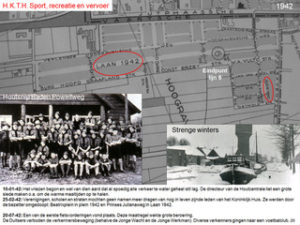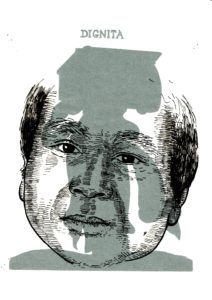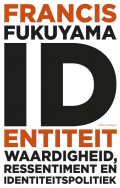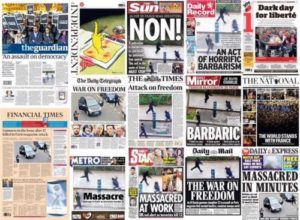
Ills.: UK Human Rights Blog
Abstract
This article assesses how contemporary definitions of Islamophobia, especially the influential Runnymede report’s definition, met difficulties and challenges after the January 2015 attacks in Paris. It analyses the reactions of European government officials, and oppositional political parties to these attacks through Political Discourse Analysis (PDA). The results show the ambiguous criteria defining Islamophobia in these speeches. The main implication is that more effort is needed to produce a refined and operational definition of Islamophobia.
Key words: Islamophobia, Runnymede Report, Charlie Hebdo attacks, European Union, populism
Introduction
The phenomenon of Islamophobia, considered as fear, dislike or prejudice against Islam and its followers, is arguably as long as Islam itself. In the contemporary world, a pivotal moment in the study of Islamophobia as a phenomenon and its definition was the publication of a report titled: Islamophobia: A Challenge for Us All (Runnymede Trust, 1997, hereafter: The RT Report) by the Commission on British Muslims and Islamophobia, established by the Runnymede Trust. In a pioneering study the independent race, ethnic and religious equality think-tank attempted at the identification of causes and reasons for the phenomenon of Islamophobia as well as defining it. According to the Runnymede Trust, Islamophobia is: ‘… a shorthand way of referring to dread or hatred of Islam – and, therefore to fear or dislike of all or most Muslims’ (The RT Report, 1). And further: ‘the term Islamophobia refers to unfounded hostility towards Islam. It refers also to the practical consequences of such hostility in unfair discrimination against Muslim individuals and communities, and to the exclusion of Muslims from mainstream political and social affairs’ (ibid.; 4). The report reached much further than a mere identification of the terminology and consequently the definition along with its characteristics (outlined below) remain the most quoted and influential study on Islamophobia as a phenomenon and from an etymological perspective. In an attempt at breaking down the causes and reasons for the ‘hatred’, ‘hostility’ and ‘discrimination’ towards Islam the authors made an essential distinction between ‘legitimate criticism’ and ‘unfounded prejudice and hostility’ towards Muslims (The RT Report; 4). Consequently, the commission proposed closed and open views towards Islam and its believers, illustrating two essentialised approaches a non-Muslim can have towards the Islamic religion and its worshippers. ‘Phobic dread of Islam is the recurring characteristic of closed views. [While] legitimate disagreement and criticism, as also appreciation and respect, are aspects of open views’ (The RT Report; 4). Identification of the two contrastive views was based on acknowledging eight main features of each of them. The eight features of the closed/open views were recognized as: monolithic/diverse; separate/interacting; inferior/different; enemy/partner; manipulative/sincere; criticism of West rejected/considered; discrimination defended/criticized; Islamophobia seen as natural/problematic (The RT Report, p. 5).
The report achieved international recognition and for a long time it was the go-to definition and study on the phenomenon of Islamophobia. However, nearly two decades on, scholars began to question the underpinning closed/open views approach (Allen, 2007, 2010). Most notably Allen (2010) highlights that the report was intended as a policy document aimed at raising awareness of the growing phenomenon of Islamophobia, influence policy makers and provide an informative resource for anyone working in the equality field and beyond (55). Initially the closed views described in the report served as an attempt at illustrating what constituted to be a prejudice against Muslims, but as Allen (2007; 5) points out, the closed views became largely the definitive of the term Islamophobia. In other words, Islamophobia is identified as a result of the closed views of Islam, but nothing more. This black and white approach simplifies the complexity and scope of the phenomenon. The grey area overlooked in this approach consists of prejudice originating not from closed views but from the differences in values, culture and world outlooks, visible in workplace interactions, education or in service provisions (ibid.). Furthermore, lack of the grey areas in the distinction between closed and open views could suggest that there are only two ways a non-Muslim could perceive Islam and its believers – either by being a closed view Islamophobe or an open view Islamophile. Allen (2007; 6) argues that the vast middle ground omitted in the report gave space to a more indirect and complex form of prejudice against Muslims. In this sense, the report ignored issues such as the niqab debate, multiculturalism and processes of religious and cultural integration.
Indeed the lack of the middle ground within open and closed views excludes the possibility of the diversification of the Muslim community and as a result creates a generalized image of what Allen calls ‘essentialised Muslims’ (Allen, 2010; 76). The ‘essentialised Muslim’ can only be viewed in two essentialised ways: from an open view perspective and a closed view perspective. ‘Consequently Islamophobia becomes reduced to a phenomenon that is both overly simplistic and largely superficial, defined more by the characteristics of the victims than the motivation and purpose of the perpetrators themselves’ (Allen, 2010; 80). By creating contrastively opposite categories, the Runnymede report does not fully address the problems of Islamophobia and what may constitute to it. It creates artificial essentialised categorizations of Muslims and non-Muslims that hardly respond to socio-political realities. More importantly though, Muslims who do not prescribe or fit into the black and white dimensions of the report – and effectively fall into the grey areas – are being excluded from the Islamophobia discourse and automatically can become the main victims of the phenomenon itself. ‘(…) Islamophobia cannot be determined, differentiated and defined by “type”of Muslims being victimized. It has to go beyond this and take into account the recognition of an actual or perceived “Muslim-ness’’ (Allen 2010; 79). Addressing Islamophobia begins from a mere generalization of the Muslim population and a further generalization of non-Muslims who perceive Islam in various ways. ‘(…) What equally emerges from this, is an Islamophobia that is ‘abstract in its understanding, definition and conceptualization, dependent upon both the views and perceptions of non-Muslims as well as the very condition, actions, beliefs and behaviors of some, rather than all Muslims themselves’ (ibid.; 80).
Allen’s analyses of the influential report opened up new dimensions to the previously simplified phenomenon and its definition. The ambiguity and complexity of it, hardly addressed during the 1990s, have been taken to a new level in the post 9/11 world, where the terminology of Islamophobia became arguably even more problematic. Scholars and authors began to question the very definition of Islamophobia and endeavored to re-define the umbrella term for all things anti-Islam. In their diverse definitions, authors such as Kumar (2012; 2), Kalin (2011; 11) concentrate on the racial dimension of the phenomenon; Lean and Esposito (2012; 13) along with Abbas (2011; 65) highlight the ‘fear’ and ‘phobia’ aspects of the phenomenon and its definition; while Nimer (2011; 78) and Ekerwald (2011), as well as aforementioned Abbas, pay attention to the cultural and religious characteristics of Islamophobia. Even Allen (2010; 190), following his elaborated criticism of the Runnymede Report attempted at re-defining the problematic definition. Yet, his 224 words long explanation, comprising of a list of all the above-mentioned factors contributing and resulting from Islamophobia is not only unquotable but more importantly: dysfunctional.
One of the most interesting descriptions of the phenomenon comes from Cesari’s (2011) contemporary socio-political definition and further explanation: ‘[Islamophobia] is a modern and secular anti-Islamic discourse and practice appearing in the public sphere with the integration of Muslim immigrant communities and intensifying after 9/11’ (ibid.; 21). ‘The term Islamophobia is contested because it is often imprecisely applied to very diverse phenomena, ranging from xenophobia to antiterrorism. It groups together all kinds of different forms of discourse, speech, and acts by suggesting that they all emanate from an identical ideological core, which is an irrational fear (a phobia) of Islam.’ (ibid.; p. 21). Cesari’s observations are perhaps the most accurate account of what is currently wrong with the definition of Islamophobia. It is its ambiguity, generality, diversity and underpinning its fear that make it impossible to apply it to all the various phenomena that can originate or follow from prejudice towards Islam. Furthermore, the term’s etymology exemplifies how the terminology grew from a simple definition of unfounded prejudice and fear to an ideology comprising complex socio-political aspects.
Commemorating the 20th anniversary of its initial publication, in 2017 the Runnymede think-tank published a follow up to the 1997 report (Elahi & Khan, 2017). The aim of the report was ‘to improve the accuracy and quality of public debate and action in response to Islamophobia’, which followed in the two decades after the publication of the original report (1). Based on the feedback on the original Runnymede report, the authors provide ten recommendations for raising awareness and acting against Islamophobia as well as formulating two new definitions. An elaborated one: ‘Islamophobia is any distinction, exclusion, or restriction towards, or preference against, Muslims (or those perceived to be Muslims) that has the purpose or effect of nullifying or impairing the recognition, enjoyment or exercise, on an equal footing, of human rights and fundamental freedoms in the political, economic, social, cultural or any other field of public life.’ (Elahi & Khan, 2017; 1); and a shortened one: ‘Islamophobia is anti-Muslim racism’ (ibid.; 1). While the report includes 16 short articles addressing the phenomenon from numerous different perspectives, the contribution of Bunglawala (2017) is particularly interesting as it tackles the question if ‘Islamophobia is more a hindrance than a help to those of us concerned with negative outcomes for individuals who are, or are assumed to be, of Muslim background’ (69). She also discusses alternative definitions of the term, such as ‘anti-Muslim racism’, ‘anti-Muslim prejudice’ or ‘anti-Muslim discrimination’, but considers retaining of the term Islamophobia necessary for two reasons. Firstly: ‘media reporting on Islam and Muslims shows that “Islam” and “Islamic” are more likely to be negatively framed in the British press than “Muslims”, thus placing group association and (perceived) group membership at the core of collective stereotyping and its consequences’ (70). And secondly: ‘reverting to a victim-centered terminology (focusing on the “Muslim”, not “Islam”) risks bifurcating the counter-narrative and dislodging it from contextual factors that are themselves collectivizing and homogenizing when it comes to Islam and Muslims’ (70). Contrary to other contributors of the new report, Bunglawala returns to the initial open/closed views approach initiated by the first Runnymede Report (72). She considers it a useful and effective development in the etymological debate on Islamophobia, especially in light of the new shortened definition considering Islamophobia as merely ‘anti-Muslim racism’. While expressing her objections, Bunglawala continues using the term Islamophobia, as do other authors in the follow up report, arguing: ‘At a time when the terms ‘Islam’, ‘Islamic’, ‘extremist Islam’ and ‘Islamist’ are prolifically used and laden with negative overtones, is it so surprising that ‘Islamophobia’ retains its potency in naming the object of hate?’ (ibid.; 72).
The debates described above show that it is necessary to a priori depart from prejudices on victims in order to examine the relevance of the definitions of ‘Islamophobia’ with regard to the manifestations they cover in a given context. Acknowledging that following the attacks of September the 11th, 2001 the debate on the definition of Islamophobia has become increasingly complex, one may wonder to what extent the resurgence of jihadism since the mid-2000s in Europe – and the reactions it has been raising – affects the relevance of this term. In order to provide answers to this question, the reactions of European politicians to the jihadist Charlie Hebdo attacks of January 2015 in Paris will be examined. These events have indeed led to a reinforcement of discriminatory discourses and practices against Muslims in the European Union (Foundation for Political, Economic and Social Research, 2016), especially in the context of debates on radicalization where Muslims are easily perceived as inner enemies (Baker-Beall, Heath-Kelly & Jarvis , 2015; Ragazzi, 2016). The reactions of politicians to this attack tend to reveal ambiguities related to the contemporary apprehension of Islamophobia. Consequently, they simultaneously call for reconsideration of the existing terminology and a further scrutiny of its implications in the political, legislative and social domains.
The following parts of the article present a methodological overview of the study (1), followed by an analysis of the collected corpus of data (2), culminating in a conclusion (3) containing proposals aimed at identifying more effectively the discriminatory discourses concerning Island and Muslims.
Methodology
On January 7 2015, Said and Cherif Kouachi, two brothers of Algerian origin, born and raised in France, committed a terrorist attack on the Charlie Hebdo Magazine office in Paris, killing eleven people using assault rifles. The following day Amedy Coulibaly, of Malian origins, also born and raised in France shot and killed a municipal officer in one of the Parisian suburbs. A two-day manhunt culminated on the 9th of January when the Kouachi brothers were shot dead by the French police following raiding a hideout of the brothers. The same day saw Coulibaly storming a kosher supermarket in Paris and killing four hostages inside the store. Coulibaly was shot dead following a police raid on the building. While all of the attackers were of Muslim faith, their understanding and commitment to the religion had been heavily disputed following an investigation (Meichtry, Bisserbe & Faucon, 2015). The Al Qaeda branch in Yemen claimed responsibility for the attacks on the Charlie Hebdo office as a response to the frequent caricatures lampooning the Prophet Muhammad (Schmitt, 2015), yet no terrorist organization claimed responsibility for Coulibaly’s actions (Burke & Mark, 2015). In a video released posthumously, Coulibaly himself claimed affiliation with the Islamic State (Borger, 2015).
If violence of this nature had always had repercussions in the public debate, that of the attack against Charlie Hebdo was unprecedented in France. In particular the fact that the attack was aimed at a newspaper that was accused of blasphemy was the subject of a particular framing of these events: an attack on ‘freedom of expression’, ‘secularism’, ‘the Enlightenment’, against ‘this is what we are’, said several members of the government (Sèze, 2019). Society felt shaken in the founding values of its collective identity. Hence the exceptionally massive identification caused by this attack: millions of tribute messages appearing on social networks, while nearly four million people, joined by some fifty heads of state, spontaneously manifested in the streets of France on January 11, 2015. This article is based on the reactions of European politicians to these attacks. Their reactions are analyzed using Political Discourse Analysis, paying particular attention to who these politicians hold responsible for this violence (Fairclough 1995, van Dijk 1993, 1997, Blommaert and Bulcaen 2000), all of this in order to evaluate how the politicians’ discourses relate to prejudices and forms of discrimination identified by definitions of Islamophobia. ‘Political actions or practices are at the same time discursive practices. In other words, forms of text and talk in such cases have political functions and implications’ (van Dijk, 1997: 14). Therefore, the reactions of political leaders as well as the programs of their parties indicate the political position of its authors.
1.1 Country and Political Party Selection
The selection of countries for analysis was based on two elements: the initial membership in the European Union and a significant Muslim population in a given country. It can be feasibly argued that countries with a longer membership and integration history maintain stronger political and diplomatic ties with each other, which consequently contributes to a higher expectation for official responses to the attack. Further, the chosen countries are among the most populated EU members, which, along with their longstanding membership in the European Union, have influential implications and can serve as an example to newer and/or less populated member states.
The initial signatories of the Maastricht Treaty in 1992 – considered as official creation of the European Union – were: Belgium, Denmark, France, Germany, Greece, Ireland, Italy, Luxembourg, the Netherlands, Portugal, Spain and the United Kingdom (Council of the European Communities and Commission of the European Communities (Maastricht Treaty), 1992). The Muslim population in all of the initial signatory states of the treaty (except for Ireland and Portugal) is higher, or significantly higher, than 2% of the overall population (Hackett, 2016). It is the 2% population threshold this study considers as ‘significant population’. Furthermore, it is feasible to argue that all of the chosen countries do not have a long history of Islam in their societies (with a notable exception of Spain and Greece for geographical reasons – in other words, directly neighboring with Muslim majority countries). The selected countries have been experiencing an influx and development of Muslim communities over the last 100 years, rather than hosting significant number of Muslim communities due to historical and geographical reasons. In other words, these are the countries at the forefront of the problematic notions of multiculturalism, cultural integration and religious pluralism in Europe.
In order for a more accurate representation and data analysis, two exceptions in the choice of countries were made. Austria (5.4% of overall country’s population is Muslim) and Sweden (4.6%) replaced two initial signatory countries with insignificant Muslim population (Ireland 1.1% and Portugal 0.3%). Both of these countries (Austria and Sweden) ratified the Maastricht Treaty in 1994, becoming the second oldest members of the European Union (Finland was the third country to sign the Treaty in 1994, however its Muslim population stands at 0.8%). Summarizing, Table 1 (below) outlines all the countries and parties selected for the study along with information on percentages of Muslims in the overall population in each country, as well as whether a party or party representative issued a statement on the attacks or not.
In order to provide an accurate picture of the European Union political spectrum, the selection of political responses to the Charlie Hebdo attacks presents a complete list of statements from parties in power (ruling parties), main opposition parties, and populist parties from selected member states. Parties in power were determined by their membership in (the leading coalition forming) the government. Opposition parties were selected according to the highest number of votes outside of the parties that won the elections or formed the leading coalition or government. The populist parties were determined by their anti-immigration, anti-Islam and anti-elitisms political stance as exemplified in the party manifestos and overall political discourse of the party. In two instances (Austria’s Freedom Party of Austria (FPÖ) and the Dutch Party for Freedom (PVV) the main opposition party and populist party categories overlapped. Due to their political stance, these parties were considered as populist parties.
It is clear that ruling parties along with their main opponents receive the biggest media coverage and therefore their responses may be considered the most influential and significant. Main opposition parties are also likely to use a stronger rhetoric in order to highlight the ruling parties response as well as possible future legislative actions, or lack of thereof, taken by the parties in power. Populist parties on the other hand, are most likely to benefit from a prejudiced discourse (van Dijk, 1993; 60), and therefore add additional dimensions to the analytical framework, consequently allowing for a complete picture of the political dialogue used in the context of the attack. Based on these considerations the study made a distinction between (1) ruling parties (including coalitions), (2) main opposition parties and (3) populist parties. Additionally, in analyzing the responses, political party manifestos have been taken into consideration allowing for a larger contextual framework.
Summarizing, out of the 12 selected countries: 33 ruling parties (including coalitions) with 20 party manifestos; 9 opposition parties with 6 manifestos; and 7 populist parties with 7 manifestos were analyzed – all together accounting for 49 political parties and 33 party manifestos.
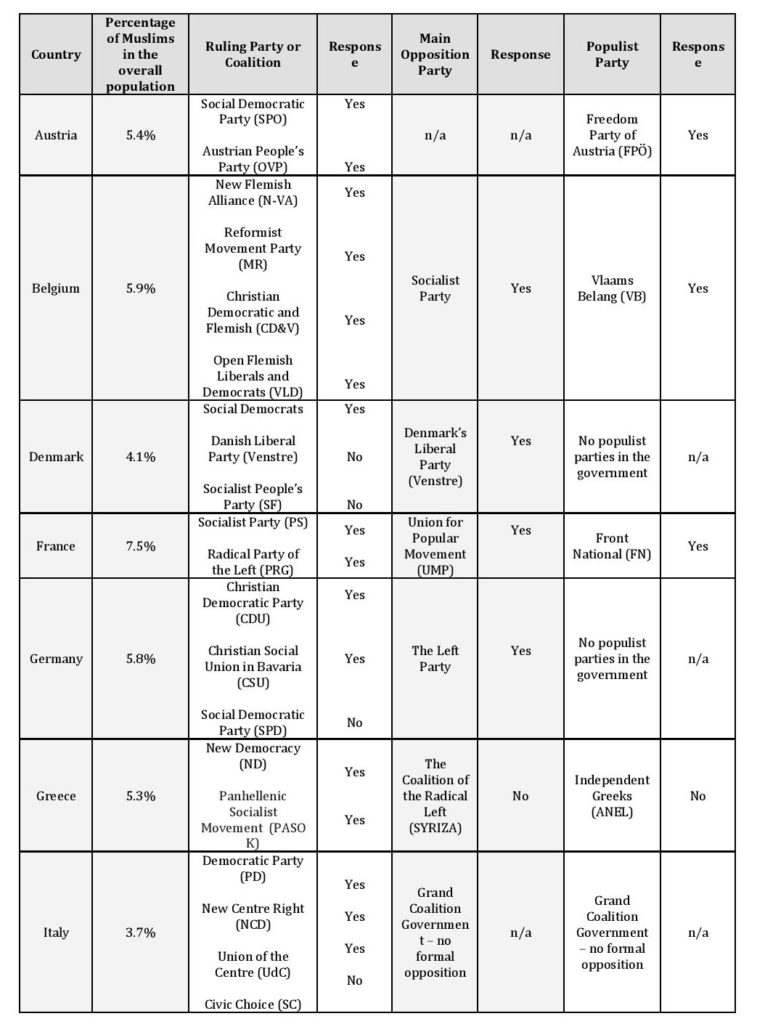
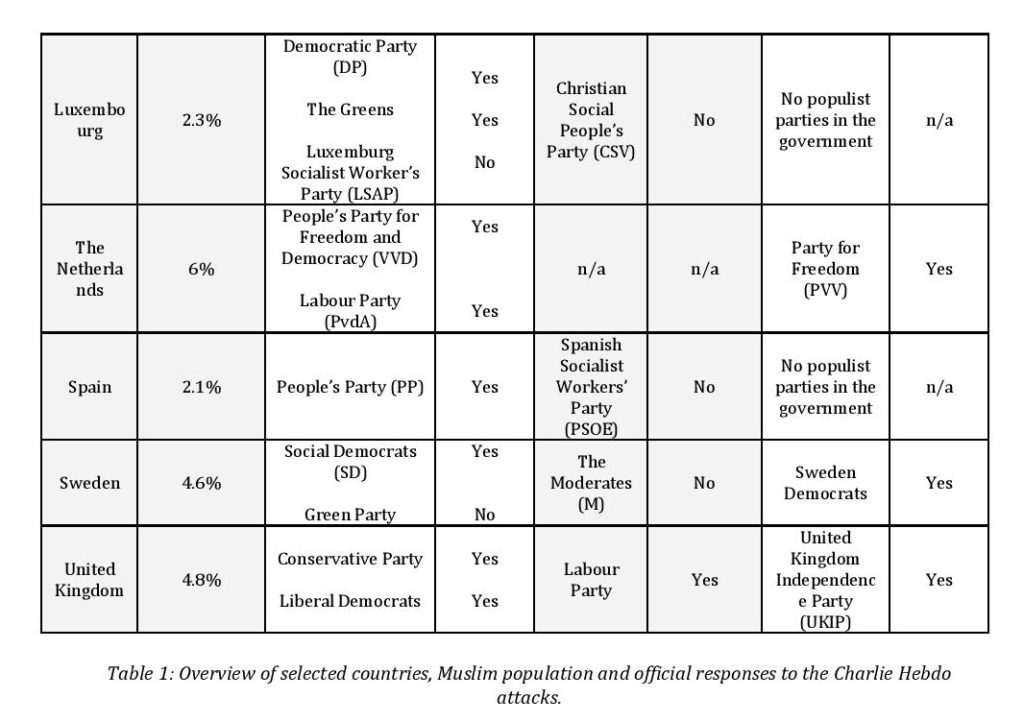
1.2 Data gathering
The method of investigation and data gathering was conducted exclusively online, using the online search engine Google – for individual leaders’ responses; and government and party websites – for official statements, press releases and party manifestos. In case a party response was not issued or a manifesto not attainable online, such instances were reported and used for further analysis. The majority of the statements were not issued in English. Consequently, translations of the responses were carried using Google Translate online software and additionally verified by native speakers of the country and language in question.
Many parties in power, in addition to their leader’s response, issued official statements on governmental websites or official party websites. If such a statement was available, it was included in the study. In five cases (Germany’s CDU, Italy’s PD, the Netherlands’ VVD, Belgium’s MR, Sweden’s SD) additional statements by other influential party politicians (not party leaders) were published on party websites – such statements were also included in the study. If political responses or statements were not published via official party or government websites, but reported by a news agency, the information was crosschecked with other media outlets. Following, appropriate quotations regarding issues concerning identification of perpetrators, blame of the attacks and any mention of Islamic religion, Muslims, terrorism or radicalization were selected and included in the list of responses and data corpus. Party manifestos or programs were downloaded from official party websites and used for supporting analyzes in order to identify the party stance on Islam and Muslims but also more generally, on racism, prejudice, religion, extremism, radicalization and terror.
Political responses were collected and formulated into a data corpus concentrating on selected quotations of the responses addressing perpetrators of the attacks as well as terrorism and religious aspects by each party and/or politician. Each entry in the corpus considered the context of the response (e.g. time of the response, medium of communication, party manifesto), as well as on the identification of the discourse on Islam and Muslims conceived in each response through identification of how the perpetrators were recognized or described by political leaders. The discourse analyses concentrated on a two-fold analytical procedure. Firstly, in accordance with the most influential definition of Islamophobia by the Runnymede Report, and following its distinctions between open and closed views towards Islam, the analyses of each party response established three crucial aspects of each response:
(1) Responsibility: Mention of the responsibility of the attacks in the statement (i.e. whom the politicians blame for the attacks);
(2) Islam or Muslims mentioned in the statement or not;
(3) Distinction made: Mention of the distinction between positive and negative aspects and members of Islamic religion in the statement.
Secondly, Political Discourse Analyses (PDA) of the responses was conducted using the analytical framework for the textual analysis discussed in van Dijk (1997, 2003) and Fairclough (1995). In doing so, the core tenants of the PDA (outlined below) are taken as a guideline for the critical analyses resulting in the identification of contemporary definitions of Islamophobia having been affected or not.
3.4 Political Discourse Analysis (PDA)
Political Discourse Analyses (PDA) can be treated as a cross-discipline deriving from Critical Discourse Analyses (CDA) building upon the core assumptions of CDA such as: discourse constitutes society and culture; discourse does ideological work; the link between text and society is mediated; discourse is a form of social action; and discourse analysis is interpretive and explanatory (Fairclough & Wodak, 1997; 271-280). PDA differs from CDA in the significance given to the political context surrounding a political discourse, as well as the reproduction of political power, power abuse or domination and ‘discursive conditions and consequences of social and political inequality [sic] that results from such domination’ (van Dijk, 1997; 11). PDA concentrates on political actors, rhetoric, context, time, medium of communication as well as any other related issue by identifying it and including it in the analytical framework – it is also resultantly characterized by it (van Dijk, 1997, 2003). The central aim of PDA is to critically evaluate a text, speech or any type of human discourse in order to extract or explore the subliminal messages, broader social context and social ramifications of the text (Fairclough, 1995; 23). Indeed, CDA’s as well as PDA’s ‘locus of critique is the nexus of language/discourse/speech and social structure’ (Blommaert & Bulcaen, 2000; 449). Critical Discourse Analyses are crucial in unraveling the hidden, as well as the more obvious power relation structures buried in a particular discourse.
Context of the political discourse in this study is the terrorist attack on the Charlie Hebdo office in Paris in January 2015 and the immediate reaction of political leaders to it. Immediate responses to such attacks are crucial, as firstly: political discourse is expected to be analyzed by political commentators (i.e. media), as well as politicians themselves; secondly: the abrupt reactions are often carried before the fully known assessment of the unfolding tragedy and therefore are more expressive and analytically compelling. In this study all of the political responses have been recorded or published within three days of the attack (with an exception of the Austrian FPÖ party leader). Actors in this process are the leaders of nationwide political parties of each selected country: those in power, the main opposition and the populist parties at the time of the attack.
Macro and micro levels of the political discourse analyzed in this study were approached as follows: macro – three levels of political power (parties in power, opposition and populist parties), as well as the relation between political parties as a social group and its audience (population of each country and by extension the population of Europe) as another social group; micro – language used in each response and verbal interaction as exemplified in various mediums of communication.
Medium of communication varied and included communication channels such as parliamentary speeches, media interviews, and official, party or government websites. The importance of medium of communication was crucial in highlighting the possible difference in responses issued officially (e.g. government website, party website, official telegraph) and unofficially (e.g. media interview, parliamentary speech).
Political Parties’ Responses
The responses of the political parties and/or leaders of the selected countries are presented in the following three sections in accordance with the methods outlined in the previous section, i.e. the responses of the ruling parties (4.1), the main opposition parties (4.2) and the populist parties (4.3).
4.1 Ruling Parties Response

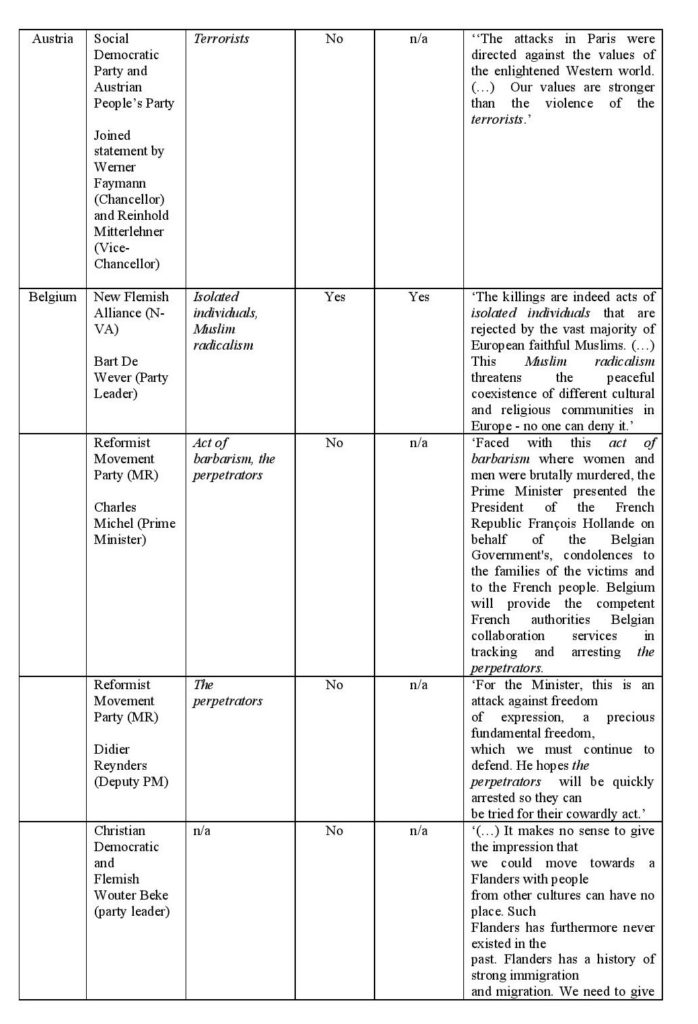
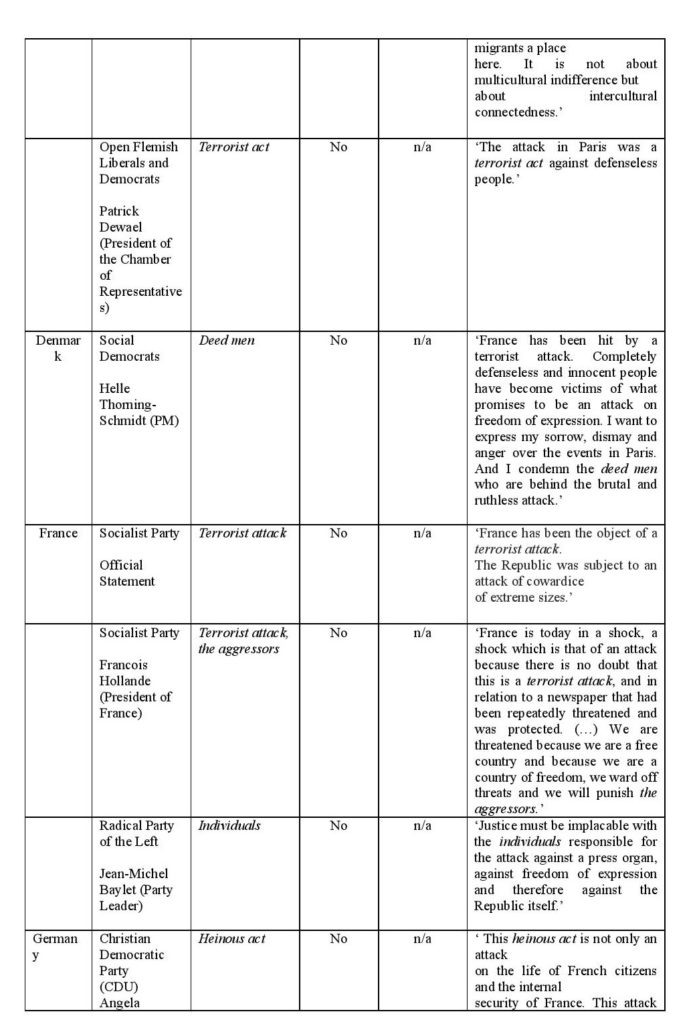
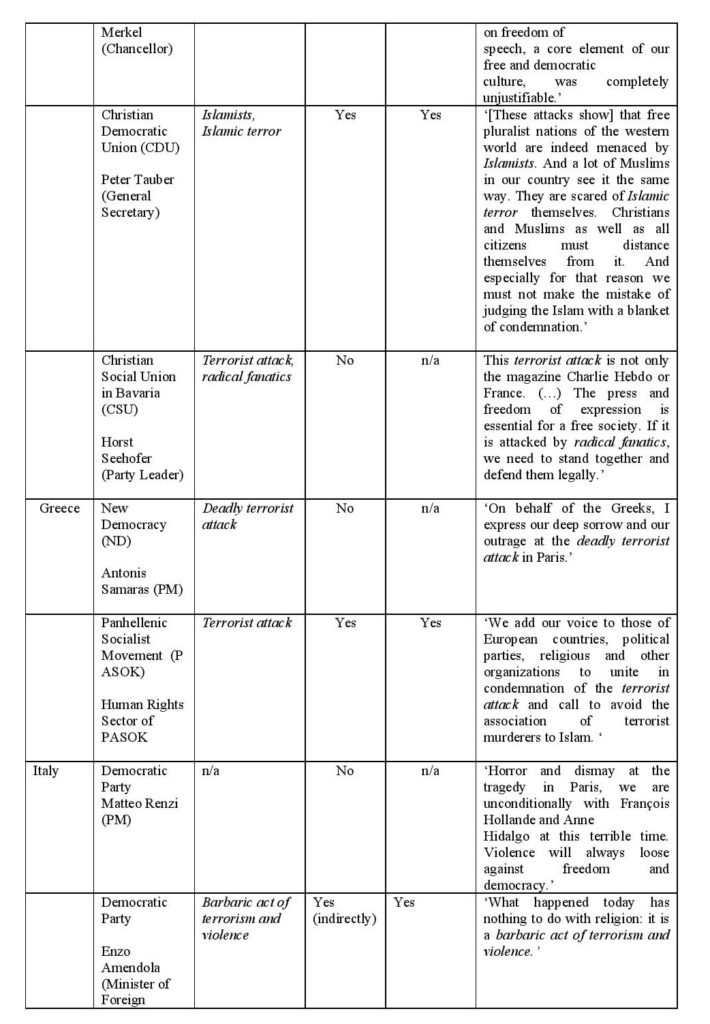
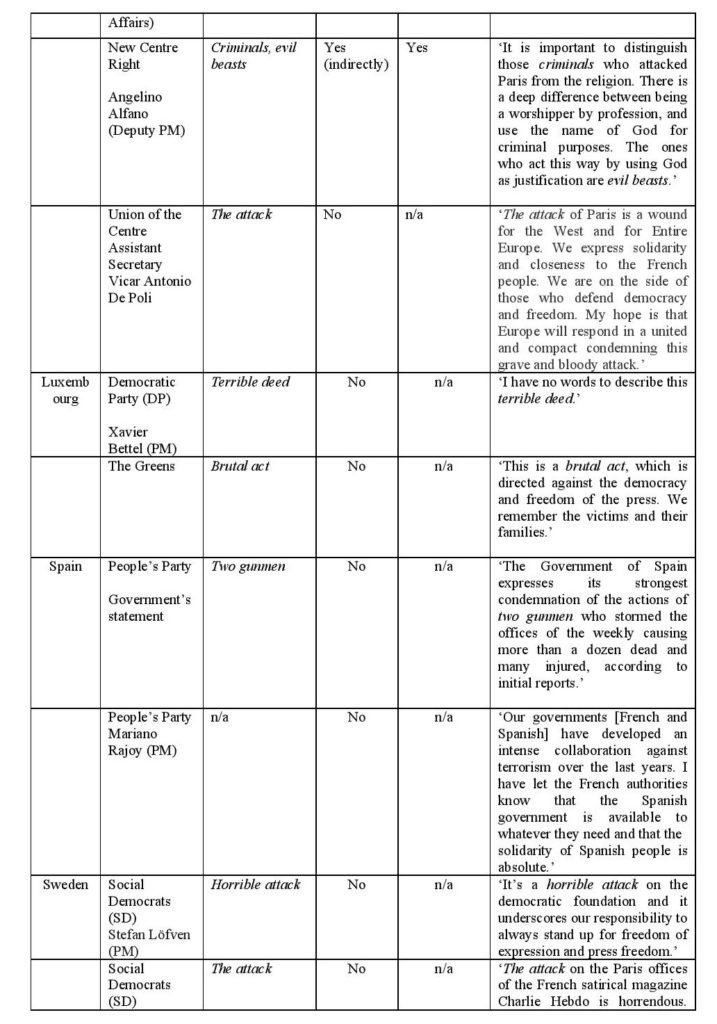
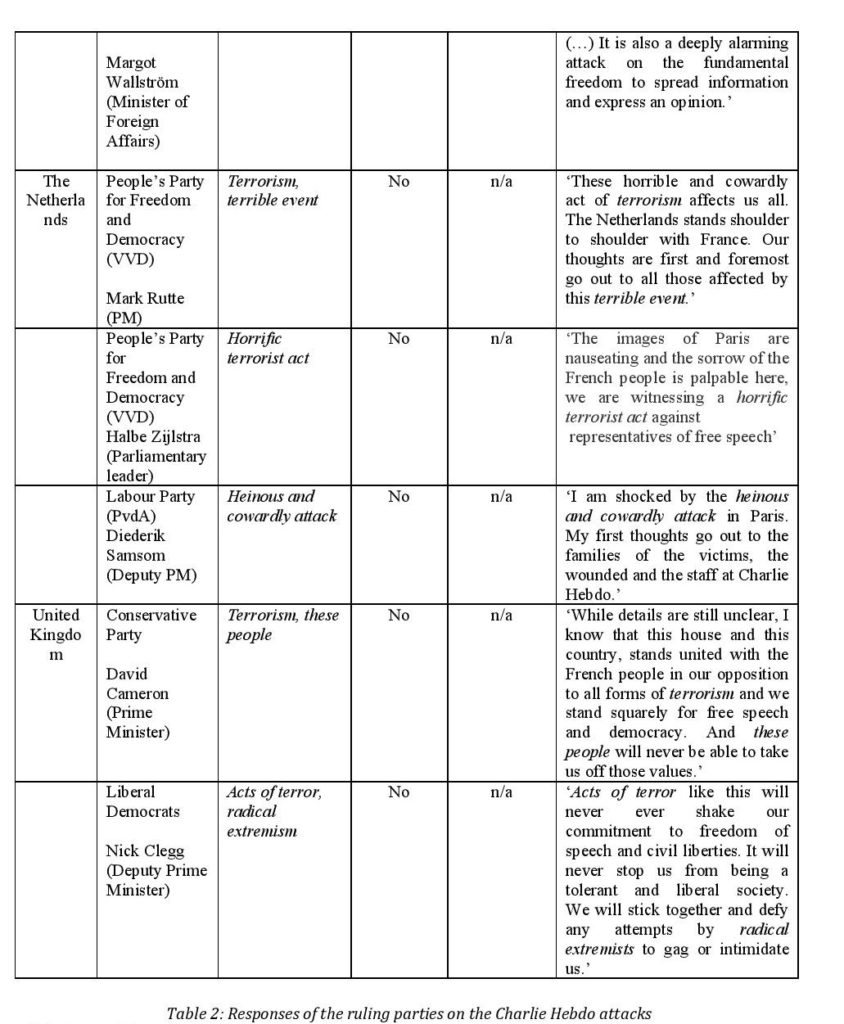
4.2 Opposition parties

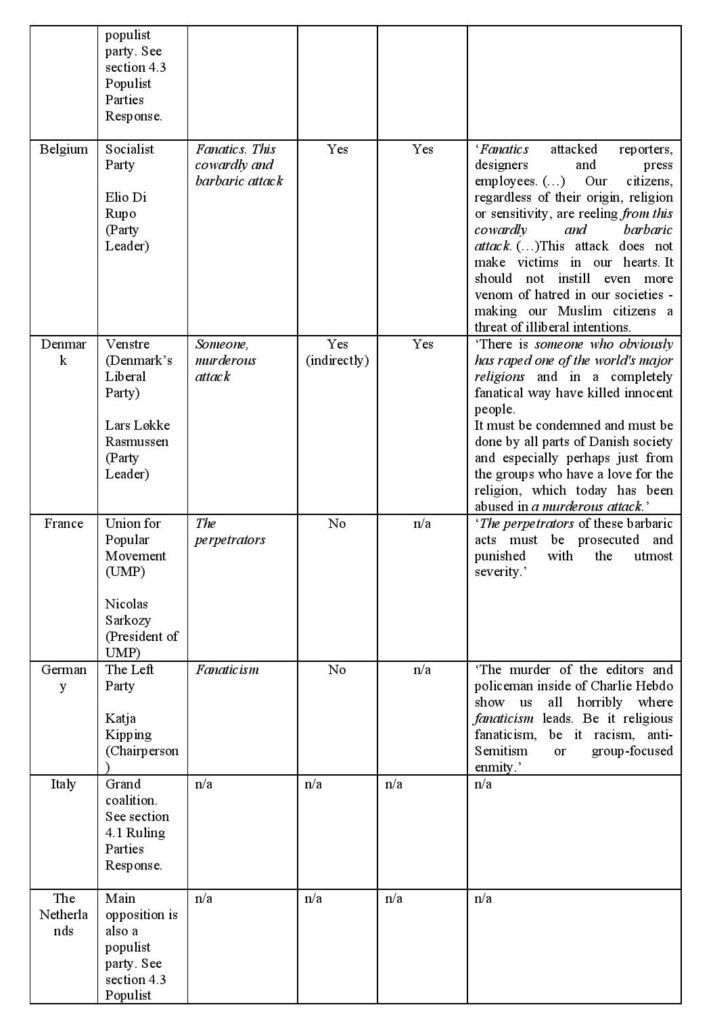

The study establishes that out of 27 statements by ruling parties (six parties did not issue a response), five mentioned Islam or Muslims in its address. All of the issued statements concentrated predominantly on condemning the attacks with calls for unity in their home countries as well as in Europe. Opposition parties’ response was less frequent. Out of five official responses, only two parties mentioned the Islamic religion or its worshippers, while simultaneously offering condolences and condemnations. Out of six populist parties’ responses (one party did not issue a statement), two parties did not explicitly mention Islam or Muslims. All the remaining four populist parties directly mentioned Islam and/or Muslims. Moreover, all four parties referred in their statements to the so-called Islamization of Europe and highlighted that their parties have foreseen a possible threat from segments of Muslims communities, while simultaneously differentiating between the two types of Muslim worshippers, i.e. the ‘good’ ones and the ‘bad’ ones like French FN leader Marine le Pen did.
Considering party manifestos, only four parties, which mention Islam and Muslims in their response, proved to do so in line with their written ideological stance (France’s FN; The Netherland’s PVV, Germany’s CDU and Belgium’s VB). In other words, these four parties use the language and argumentation in the response as outlined in their manifesto. Three other parties (Germany’s CSU and Left Party; and Spain’s PP) did not make such references in their responses even though their manifestos make a reference to the connection between Islam and Muslims communities and terrorism and radicalization.
The discrepancies of the responses are also visible when the means of communication is taken into account. No official governmental statement, i.e. issued using official communication channels of a country’s incumbent government, mentions Islam or Muslims by name. However, out of 11 statements that mention Islam and/or Muslims, nine responses were issued using individual party websites – exemplifying a party stance rather than a country’s government (Ruling parties: Belgium’s N-VA, Germany’s CDU, Italy’s NCD, Greece’s PASOK; Opposition parties: Belgium’s Socialist Party; Populists: France’s FN, the Netherlands’ PVV, Austria’s FPÖ, Belgium’s VB), one was recorded by media (Opposition parties: Denmark’s Venstre), and one was expressed in parliamentary speech (Ruling parties: Italy’s Democratic Party).
3. The gray zone of the debates on Islamophobia
3.1 Analysis of the responses
The discourse used to describe the perpetrators of the attack was acutely diverse and reflected the parties’ position in the government and therefore the macro and micro levels as discussed by van Dijk (2003). A majority of the ruling parties used the passive voice structure method in their responses to the attack by referring to the attackers as individuals, deed men, criminals or simply assigning the responsibility of the attack to terrorism or radicalism. When it comes to the parties which’ responses included references to Islam and Muslims, only two out of five ruling parties put the responsibility of the attacks on Islamists (Germany’s CDU) and Islamic Radicalism (Belgium’s N-VA) – in both cases following the Runnymede distinction between peaceful worshippers and religious fanatics. The other three ruling parties, while mentioning Islam or Muslims in their statements, placed the blame on terrorism and violence (Italy’s DP), terrorism and criminals (Italy’s NCD) and terrorist murderers (Greece’s PASOK) – in all cases making the key distinction. To the contrary, opposition and populist parties were more frequent and direct in voicing the responsibility of the attacks. Two of the opposition parties which mention Islam and/or Muslims in their statements assigned the blame to attack and ‘someone who obviously has raped one of the world’s major religions’ (Denmark’s Liberal Party), and fanatics and fanaticism (Belgium’s Socialist Party) – once again in both cases making the key distinction. The four populist parties placed the responsibility directly and expressively on: Islamic fundamentalism and radical Islam (France’s FN); Islam, Koran and Muhammad (the Netherlands’ PVV); radical Islamism and Islamic terror (Austria’s FPÖ) and jihad and Islam (Belgium’s VB). Importantly, three populist parties acknowledged the supposed dichotomy of Islamic religion and its worshippers. Belgium’s VB is the only party in this study, which places the blame on either Islam or Muslims and does not acknowledge the key distinction.
Discourse and stance taken by the leader of each government can be explained by the macro level of its political position (van Dijk, 2003): the response of the parties in power, issued by every ruling party and its careful use of words when it comes to placing the blame of the attacks; the opposition, which often did not issue an official statement; and populist parties which generally proved more explicit in their statements. Overall, leaders of all analyzed parties presented discourse appropriate for their (political) social groups, political agendas and as such all of the responses, or lack thereof, can be taken as expressive social acts in itself (ibid.) (e.g. calls for national unity; declaration of war with Islam; de-Islamization of our societies; increased security in major cities; no response at all).
The obvious influence of the socio-political situation, as well as party stance in each country follows the PDA’s core assumption: actors (politicians) participating in a political discourse do not act in a vacuum and therefore any analysis has to take into consideration the audience of each party and country’s population (van Dijk, 1993; 3). Politicians in Belgium (N-VA – ruling party) and France (FN – populist party) referred to the increasingly problematic radicalization in culturally and religiously diverse communities; General Secretary Peter Tauber of the German CDU (ruling party) highlighted the increasingly problematic notion of European religious pluralism being threatened by Islamists, resonating fear of increasing support for PEGIDA movements in Germany; and in Greece, Antonis Samaras (ND – ruling party) linked the dangers of terrorism and radicalization to the ongoing refugee crisis.
The common practice used in the majority of the opposition and populist parties’ responses echoes ideological reasoning and construction and maintenance of selves, social categories and social realities (Blommaert & Bulcaen, 2000; 449). As the results demonstrate, the discursive practices used in many of the statements comprise of techniques such as differentiation between ‘us’ vs. ‘them’ (e.g. France’s PRG leader’s use of linguistic structures such as these people and our secular values), as well as linguistic differentiation and deliberations using formal and informal speech directed at various social groups and realities (e.g. UKIP’s Nigel Farage simplistic discourse directed at his core, working-class audience; use of very strong and direct language by the Netherlands’ Geert Wilders; but also, Katja Kipping of the German’s Left Party, in her liberally careful and sociologically analytical response). The differentiation between ‘majority of Muslims’ and ‘religious radicals’ exemplifies a semantic move referred to as disclaimer (van Dijk, 2003). Such discursive practice was present on various political levels: parties in power (e.g. Belgium’s N-VA leader acknowledged the ‘radicalization of some European Muslims circles’ as an existing and immediate threat to public safety, simultaneously pointing out that ‘the killings are indeed acts of isolated individuals’); and opposition and populists parties, e.g. the Netherland’s PVV leader proclamation that ‘It is Islam that inspires the murders every time again. It is Muhammad, (…) it is the Koran. (…) Of course I’m not talking about all Muslims’; France’s FN leader’s response in which the attackers were influenced by a ‘murderous ideology’ as the attacks were committed ‘in the name of radical Islamism’ and therefore an ‘absolute refusal of Islamic fundamentalism must be proclaimed high and loud’, yet at the same time ‘nobody wants to confuse Muslims compatriots who are attached to your nation and to her values with those who kill in the name of Islam’.
There appears to be a clear connection underlying all the responses across the European political spectrum: the lack of appropriate terminology seems to be pushing the politicians from one extreme to another – between over elaborated political correctness to waging a military conflict with a religious ideology. Moreover, whether a direct accusation or reference, passive voice or disclaimers, it all comes down to the fact that the Charlie Hebdo attack reinforced the possibility of homegrown radicalization and assault in the name of international terrorist organizations – and fear thereof. Fundamentally, the political discourse analyses reveal a clear pattern emerging from the collective responses. In all but one case where Islamic religion or its worshippers are mentioned, politicians make a clear differentiation between radical Islam, fundamentalism or Islamic terror and the majority of ordinary Muslim population. This was the case even for parties openly hostile to the Islamic religion such as the populist Front National (France) and Party for Freedom (the Netherlands). The notable exception comes from Belgium’s populists, Vlaams Belang, which expressively and solely placed the blame for the attacks on jihadist, Islam and the ever-increasing Islamization of Europe. Indeed the statement proved in line with the party manifesto in which growing Muslim extremism is described as a main threat to public order in Belgium. Summarizing, the results empirically prove that the differentiation between religious radicals and peaceful worshippers in the context of Islam and Muslims has become an almost exclusive way of referring to terrorists associated with Islamic religion.
3.2 Definition of Islamophobia: an Ongoing Confusion
The acknowledgement of the dichotomy in Islamic religion and Muslim worshippers can be taken as an escape route from being accused of Islamophobia. In other words, differentiation between two types of Islam becomes an official line of defense in legislative terms. Such problematic reality is arguably reinforced by the influential Runnymede Report 1997, which initiated the differentiation between open and closed views of Islam – the legitimate criticism and unfounded prejudice and hostility, as well as lack of lack of criticism for it in the follow up report from 2017. In accordance with the reports’ findings, as long as a person acknowledges the diversity of Islam, and therefore presents an open view of the religion by expressing a legitimate criticism of it, such person cannot be prescribed as an Islamophobe. Applying this reasoning to the politicians analyzed in this thesis, only Tom van Grieken and Barbara Pass (Belgium’s populists, Vlaams Belang) could feasibly be described as Islamophobes as they fail to acknowledge the diversity of Islamic worshippers and make prejudice generalizations against an entire religious group. Indeed, as Allen (2010) argues, people with openly unfavorable views of Islam, often making sweeping generalizations about the Islamic religion and proclaiming that Islam, its prophet and believers are main, or even sole, reasons for terrorist attacks, may escape the accusation of being Islamophobic, merely by acknowledging that they do not talk about all Muslims.
Due to the multitude of definitions of Islamophobia, which are constantly contested, it becomes almost impossible to apply any of the various definitions to the politicians analyzed in this study: be it a ruling, opposition or populist party. Contemporary definitions by Kumar (2012), Kalim (2011) or Nimer (2011) concentrating largely on racism as exemplified by being hostile, prejudiced or discriminatory to a religious group appear accurate and truthful in their formulation and intentions. Yet, instead of referring to a group, one can easily concentrate on using disclaimers and formulations such as isolated individuals – as this study has illustrated – and therefore avoiding accusations of Islamophobia while simultaneously maintaining the elephant in the room condition of groupthink. The definitions proposed by Allen (2010), Ekerwald (2011) or Cesari (2011), while arguably more applicable in this instance as they acknowledge fear, ideology that radiates negative meanings to Muslims and Islam, and the large diversity of phenomena that Islamophobia is meant to correspond to, also appear to fail to address political discourses by various politicians. This is particularly true for the large amount of political statements using passive voice structures and/or the acknowledgement of the Runnymede dichotomy of Islam and Muslims. The term Islamophobia is supposed to address the issue of religious simplification and/or generalization. Yet the Runnymede reports, just as other attempted definitions of Islamophobia, appear to have failed in this regard – arguably contributing to a greater confusion of the problematic relationship between race, religion and culture.
Grosfoguel (2012) argues that there is an easy escape route of being proclaimed a racist when expressing negative opinions toward Muslims: ‘by focusing on the “other’s” religion, the Europeans, Euro-Americans and Euro-Israelis manage to escape being accused of racism. However, when we examine carefully the hegemonic rhetoric in place, the tropes are a repetition of old biological racist discourse and the people who are the target of Islamophobic discourses are the traditional colonial subjects of the Western Empires (…). It is absolutely impossible to delink the hate or fear against Muslims from racism against non-European people. Islamophobia and cultural racism are entangled and overlapping discourses’ (13-14). Politicians analyzed in this study, as well as their audiences, are therefore unable to recognize unfounded, generalized criticism of the entire religion as racism towards people of another ethnicity.
Furthermore, Reisigl and Wodak (2001) convincingly argue that any ‘phobic’ discourse or terminology cannot address racism or discrimination. To paraphrase their reasoning: ‘[Islamophobia] neglects the active and aggressive aspect of discrimination and, second, it pathologises racism (and all the other forms of discrimination covered by [Islamophobia]) through the “disease metaphor” of “phobia”, which as such plays down racism and, at least implicitly, exculpates racists’ (ibid.; 6).
Analytical deconstruction of the political discourse used in the responses, contrasted with contemporary definitions of Islamophobia, proves that the term is not only ambiguous and confusing, but more importantly it fails to address the diversity and complexity of the phenomenon, especially when considered as racism. People, and politicians in particular, are quick to exploit the theoretical loopholes to avoid being called on their demagogy or racism.
3.3 Islamophobia: Re-evaluation
Faced with the difficulties treated above, there appear to be two solutions to approaching the term and meaning of Islamophobia– , which were previously attempted:
– Alternative definition. The multitude of existing definitions of Islamophobia convincingly indicates that any effort at redefinition of the term is insufficient.
– Alternative terminology. Allen (2010; 135-137) provides a good overview of alternative terminology, which concentrates on Muslims as people, and Islam as religion separately. Among the proposed and analyzed definitions were terms such as anti-Muslimism and anti-Islamism. Readings, Brandon and Phelps (2010) also suggest altering the Islamophobia terminology into anti-Muslim prejudice, anti-Muslim bigotry, anti-Muslim hatred, but the scholars do not provide any further reasoning or explanation for it, apart from the fact that Islamophobia, as a term, is too general. Furthermore, De Ruiter (2012) in his analyses of Geert Wilders’ (PVV leader) discourse on Muslims and Islam identifies the problems in the distinction between Islam and Muslims. De Ruiter () argues that it is impossible for any Muslim believer to detach him/herself from the teachings of Koran, or from their “religious lineage” (Hervieu-Léger, 1993). Following this distinction, Muslims have only two choices of placing themselves in this argument – either stop following the teachings of Koran (and therefore cease to be considered as Muslims) or continue to be associated with a violent ideology of Islam by simply adhering to religious practices prescribed in Koran. Allen (2010; 135-137) rightly identifies the problematic one-dimensional characteristics of each of the above listed alternate definitions, as well as further problems with the term Islamism itself (e.g. being increasingly associated with radical forms of Islamic religion). Moreover, he rightly argues that the replacement of already existing terminology may result in a long process of linguistic assimilation, merely contributing further to the overall confusion of the phenomenon.
At the crossroad of the two discussed approaches, a third solution arises in considering a complementary terminology. While the term Islamophobia is largely characterized by the ongoing confusion between ordinary Muslims and those who legitimize violence in the name of Islam (e. g. particular Islamist organizations and jihadism), the challenge is to introduce a terminology that would encourage the distinction between the two. As such the debate is comparable with the confusion between anti-Semitism and anti-Zionism (a criticism of Israel’s Zionist policies – a definition nonetheless controversial). Corrigan (2009) emphasizes in this respect that it is legitimate, in a democracy, to criticize Zionism without being anti-Semitic, Nazism without expressing a dislike towards the Germans, torture practiced by the American army in Iraq without being racist against Americans. It is in the same way legitimate to criticize certain manifestations of Islam without being racist towards Muslims. This additional term could, for example, target illegal or violent varieties of Islam, as is customary in European political discourse (e. g. various politicians describe the perpetrators of the attacks as ‘Islamists’: Rassemblement National in France, CDU and CSU in Germany, FPÖ in Austria). Readings, Brandon and Phelps (2010), who stress the importance of language as a political tool, show how the representations of the world conveyed by Islamism resonate with those of the far right: ‘The belief that “the Muslim world” is a homogeneous bloc sharing the same political agenda’; ‘The belief that the world should be divided into rival and competing blocs, with Muslims on one side and non-Muslims on the other’; ‘Islamists from all walks of life believe that Muslim behavior should be determined by their religion alone’; ‘Islamists believe that a unique interpretation of sharia […] can and must be imposed on society’ (2010: 3-14). The introduction of the term ‘anti-Islamism’ or ‘anti-Jihadism’ would reduce the risk of confusion between prejudices against Islam and Muslims on the one hand, and illegal or violent actions in the name of Islam on the other hand.
3.4 Conclusion
Placed in a historical perspective, the Islamophobia debate highlights one of the limitations of the Runnymede Report: the opposition between legitimate criticism of Islam and Muslims and objectionable/reprehensible criticism of Islam and Muslims creates/leads to essentialist representations of both of them. These representations in their turn generate a gray zone, which goes beyond the fight against Islamophobia (i.e. prejudices which do not proceed from ‘closed attitudes’). Recent debates such as controversies over the niqab or the ‘crisis of multiculturalism’ make it necessary to reconsider this space. The analyses of the political reactions to this event, by means of PDA, reveal how openly anti-Islam parties are playing with the confusion allowed by this delicate balance between freedom of expression and equality of individuals – the foundations of modern democracies. If the renunciation of this terminology remains undesirable, the refinement of the definitions of Islamophobia seems necessary without being able to remedy it. While the introduction of the term ‘anti-Islamism’ would refine the debate, it also raises questions. It is not enough to overcome the criticism of the Runnymede report’s definition of Islamophobia, since the question of legitimate or reproachable criticism of Islam and Muslims (and the underlying essentialist representation of Muslims) remains unanswered (should it extend to all forms of Islamism or remain limited to jihadism?). Moreover, the controversies about the differentiation of anti-Semitism and anti-Zionism remind us of the limits of this proposition: to distinguish between a policy with a religious referent, and the populations who identify with this religion does not prevent these prejudices. In the same way that anti-Zionism sometimes conceals anti-Semitism, anti-Islamism / jihadism is sometimes an expression of hostility towards all Muslims. Should this be enough to give up the need for such a proposal? Unlikely, or, as in the words of Albert Camus (2008; 908): ‘Badly naming an object is adding to the misery of this world’. This study is meant to be nothing more than a hopefully fruitful contribution to the debates on Islamophobia that seem to have a challenging future ahead of them.
References
Abbas, T. (2011). ‘Islamophobia in the UK: Historical and Contemporary Political and Media Discourses in the Framing of a Twenty-First century Anti-Muslim Racism’, in: J. Esposito and I. Kalin (eds.): Islamophobia: The Challenge of Pluralism in the 21st Century, 1st ed. New York: Oxford University Press, 11.
Allen, C. (2007). The ‘first’ decade of Islamophobia: 10 years of the Runnymede Trust report “Islamophobia: a challenge for us all”. Published by the author.
Allen, C. (2010). Islamophobia. Farnham, Surrey: Ashgate.
Bahçecik, S.O. (2013). ‘Internationalizing Islamophobia: Anti-Islamophobic Practices from the Runnymede Trust to the Organization of Islamic Cooperation’, in: Ortadoğu Etütleri, 5(1).
Baker-Beall, C., C. Heath-Kelly & L. Jarvis (eds.) (2015), Counter-Radicalization. Critical perspectives, London/New York: Routledge.
Blommaert, J. & Ch. Bulcaen (2000). ‘Critical discourse analysis’, in: Annual Review of Anthropology, 29: 447-66
Bunglawala, S. (2017). ‘What’s in a name’, in: F. Elahi & O. Khan (eds.): Runnymede. A 20th-anniversary report. Islamophobia. Still a challenge to us all. London: Runnymede Trust, 69-72.
Camus, A. (2008). Sur une philosophie de l’expression, Œuvres complètes, vol. 1. Paris: Gallimard, Pléiades collection.
Cesarani, D. (2006). ‘Anti-Zionism in Britain, 1922–2002: Continuities and Discontinuities’, in: Journal Of Israeli History, 25(1), 131-160.
Cesari, J. (2011). Islamophobia in the West: A Comparison Between Europe and America, in: J. Esposito and I. Kalin (eds.): Islamophobia: The Challenge of Pluralism in the 21st Century, 1st ed. New York: Oxford University Press, 21.
Corrigan, E. (2009). ‘Is Anti-Zionism Anti-Semitic? Jewish Critics Speak’, in: Middle East Policy, 16(4), 146-159.
Council of the European Communities and Commission of the European Communities, (1992). Treaty on European Union (Maastricht Treaty). Luxembourg: Office for Official Publications of the European Communities. Retrieved from http://europa.eu/eu-law/decision-making/treaties/pdf/treaty_on_european_union/treaty_on_european_union_en.pdf
Dijk, T.A. van (1993). Elite discourse and racism. Newbury Park, California: Sage Publications.
Dijk, T.A. van (1997). ‘What is Political Discourse Analysis?’, in: Belgian Journal of Linguistics, 11-52.
Dijk, T.A. van (2003). ‘Critical Discourse Analysis’, in: D. Schiffrin, D. Tannen and H. Hamilton (eds.): The Handbook of Discourse Analysis. Blackwell Publishing.
Ekerwald, H. (2011). ‘Islamophobia’, in: Ethnic and Racial Studies, 34 (10), 1775-1776.
Elahi, F. & O. Khan (eds., 2017). Runnymede. A 20th-anniversary report. Islamophobia. Still a challenge to us all. London: Runnymede Trust.
Esposito, J. & İ. Kalim (2011). Islamophobia. New York: Oxford University Press.
Fairclough, N. (1995). Critical Discourse Analysis: The Critical Study of Language. Longman.
Fairclough, N. L. & R. Wodak (1997). ‘Critical discourse analysis’, in: T. A. van Dijk (ed.), Discourse Studies. A Multidisciplinary Introduction, Vol. 2. Discourse as Social Interaction. London: Sage, 258-284.
Foundation for Political, Economic and Social Research (SETA). (2016). European Islamophobia Report 2015. Ankara: Foundation for Political, Economic and Social Research (SETA). Retrieved from http://file.setav.org/Files/Pdf/20160324132020_eir_2015.pdf
Grosfoguel, R. (2012). ‘The Multiple faces of Islamophobia’, in: Islamophobia Studies Journal, 1(1), 9-33.
Hackett, C. (2016). 5 facts about the Muslim population in Europe. Pew Research Center. Retrieved 23 September 2017 from http://www.pewresearch.org/fact-tank/2016/07/19/5-facts-about-the-muslim-population-in-europe/
Hervieu-Léger, D. (1993). La religion pour mémoire. Paris: Le Cerf.
Kalin, I. (2011). ‘Islamophobia and the Limits of Multiculturalism’, in: J. Esposito and I. Kalin (eds.): Islamophobia: The Challenge of Pluralism in the 21st Century, 1st ed. New York: Oxford University Press, 11.
Kumar, D. (2012). Islamophobia and the politics of empire. Chicago : Haymarket Books.
Lean, N. & J. Esposito (2012). The Islamophobia industry. London: Pluto Press.
Myers, D. (2006). ‘Can There Be a Principled Anti-Zionism? On the Nexus between Anti-Historicism and Anti-Zionism in Modern Jewish Thought’, in: Journal of Israeli History, 25(1), 33-50.
Nimer, M. (2011). ‘Breaking the Vicious Cycle of Islamophobia and Anti-Americanism’, in: J. Esposito and I. Kalin (eds.): Islamophobia: The Challenge of Pluralism in the 21st Century. New York: Oxford University Press, 78.
Ragazzi, F. (2016), ‘Suspect community or suspect category? Counter-terrorism as “policed multiculturalism”’, Journal of Ethnic and Migration Studies, 42(5), 724-741.
Readings, G., J.Brandon & R. Phelps (2010). ‘Islamism and Language: How using the wrong words reinforces Islamist narratives’, in: Quilliam, Concept Series 3.
Reisigl, M. & R. Wodak (2001). Discourse and discrimination. London: Routledge.
Ruiter, J.J. de. (2012). ‘The Distinction between Islam and Muslims in the Dutch anti-Islamization Discourse’, in: Canadian Journal of Netherlandic Studies/Revue canadienne d’études néerlandaises 33.2/34.1: 35-58.
Runnymede Trust, (1997). Islamophobia: A Challenge For Us All. London: Runnymede Trust.
Sèze, R. (2019). Prévenir la violence djihadiste. Les paradoxes d’un modèle sécuritaire. Paris: Seuil.
Sternberg, E. (2015). ‘The origin of globalized anti-Zionism: A conjuncture of hatreds since the Cold War’ in: Israel Affairs, 21(4), 585-601.
Online resources
Borger, J. (2015). ‘Paris gunman Amedy Coulibaly declared allegiance to Isis’ in: The Guardian UK. Retrieved 23 September 2017 from https://www.theguardian.com/world/2015/jan/11/paris-gunman-amedy-coulibaly-allegiance-isis
Burke, J. & M. Mark (2015). ‘Al-Qaida in Yemen uses video to claim responsibility for Charlie Hebdo attack’, in: The Guardian UK. Retrieved 23 September 2017, from https://www.theguardian.com/world/2015/jan/14/al-qaida-claims-responsibility-charlie-hebdo-attack-paris
Islamism. (2016). Oxford Dictionary. Retrieved from http://www.oxforddictionaries.com/definition/english/islamism
Meichtry, S., N. Bisserbe & B. Faucon (2015). ‚Paris Attacker Amedy Coulibaly’s Path to Terror’, in: Wall Street Journal. Retrieved 9 May 2016, from http://www.wsj.com/articles/paris-attackers-path-to-terror-1421204761?cb=logged0.5047967159189284
Runnymede Trust. (2016). ‘Oral Histories’, in: Runnymedetrust.org. Retrieved 8 May 2016, from http://www.runnymedetrust.org/histories/
Schmitt, E. M. (2015). ‘Disputed Claims Over Qaeda Role in Paris Attacks’, in: Nytimes.com. Retrieved 23 September 2017, from https://www.nytimes.com/2015/01/15/world/europe/al-qaeda-in-the-arabian-peninsula-charlie-hebdo.html?mcubz=0
 Voor ons is het een ongelukkige tijd. De laatste weken blijven de verontrustende berichten komen, iedere dag brengt een nieuwe catastrofe. Eerst het geld, nu moet ook het huizenbezit worden opgegeven, en gisteravond kregen we van het stadhuis de mededeling dat Sonja vanaf 1 september niet meer naar het lyceum mag. Er worden scholen met Joodse leraren gevormd, alle Joodse kinderen moeten daarheen. Ik huilde en mijn dienstmeisje, dat zo op Sonja is gesteld, barstte in snikken uit, zo’n verdriet had ze ervan. Het arme kind, ze hing zo aan de school, had zoveel vriendinnen, leerde zo graag en goed en nu moet ze haar beste vriendin Elsje missen. Wat een geluk dat Inge het eindexamen achter de rug heeft, en wat zal er met Hans gebeuren? Zal hij verder mogen studeren? Ik koester weinig hoop en denk van niet. Een volle Jood moet worden vernietigd.
Voor ons is het een ongelukkige tijd. De laatste weken blijven de verontrustende berichten komen, iedere dag brengt een nieuwe catastrofe. Eerst het geld, nu moet ook het huizenbezit worden opgegeven, en gisteravond kregen we van het stadhuis de mededeling dat Sonja vanaf 1 september niet meer naar het lyceum mag. Er worden scholen met Joodse leraren gevormd, alle Joodse kinderen moeten daarheen. Ik huilde en mijn dienstmeisje, dat zo op Sonja is gesteld, barstte in snikken uit, zo’n verdriet had ze ervan. Het arme kind, ze hing zo aan de school, had zoveel vriendinnen, leerde zo graag en goed en nu moet ze haar beste vriendin Elsje missen. Wat een geluk dat Inge het eindexamen achter de rug heeft, en wat zal er met Hans gebeuren? Zal hij verder mogen studeren? Ik koester weinig hoop en denk van niet. Een volle Jood moet worden vernietigd.